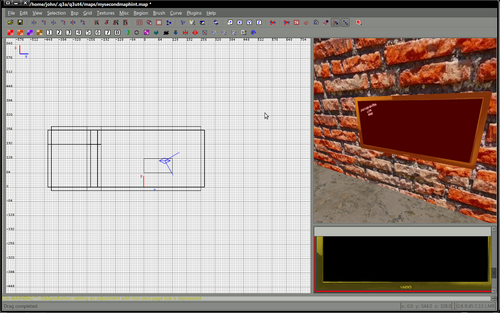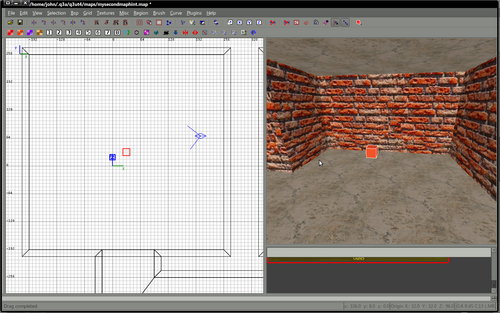Difference between revisions of "Mapping:Adding a camera to your map"
(→Connect the entities together) |
|||
| (4 intermediate revisions by 3 users not shown) | |||
| Line 41: | Line 41: | ||
==Create a TV screen== | ==Create a TV screen== | ||
| − | + | {| width="100%" style="padding-left:5%;" | |
| + | |style="padding-right:5%;vertical-align:top"| | ||
Create a simple (detail) brush in your map where you'd like your TV to be. | Create a simple (detail) brush in your map where you'd like your TV to be. | ||
| − | |||
| − | |||
Texture the top and sides, perhaps the bottom if anyone is likely to look there. | Texture the top and sides, perhaps the bottom if anyone is likely to look there. | ||
| − | |||
Select the front face, the actual screen of your TV | Select the front face, the actual screen of your TV | ||
| − | |||
| − | Apply the | + | Apply the "tvscreen" shader to this face and fit it to size. |
| + | |||
| + | | | ||
| + | |||
| + | |||
| + | [[File:Tut camera create tv.png|500px]] | ||
| + | |||
| + | |||
| + | [[File:Tut camera texture tv.png|500px]] | ||
| + | |||
| + | |||
| + | [[File:Tut camera select face.png|500px]] | ||
| + | |||
| − | [[File:Tut camera front.png| | + | [[File:Tut camera front.png|500px]] |
| + | |} | ||
==Create the entities== | ==Create the entities== | ||
| + | {| width="100%" style="padding-left:5%;" | ||
| + | |style="padding-right:5%;vertical-align:top"| | ||
| + | |||
First of all create an entity of misc_portal_surface and place it within 64 units of your "tv scren" surface. | First of all create an entity of misc_portal_surface and place it within 64 units of your "tv scren" surface. | ||
| Line 66: | Line 79: | ||
value : screen1 | value : screen1 | ||
| − | + | ||
Then create a misc_portal_camera and place it in the other room. | Then create a misc_portal_camera and place it in the other room. | ||
| Line 85: | Line 98: | ||
value : camera1 | value : camera1 | ||
| − | |||
This should connect all the entities together and your map should look like this.. | This should connect all the entities together and your map should look like this.. | ||
| + | | | ||
| + | [[File:Tut camera item1.png|500px]] | ||
| + | [[File:Tut camera item2.png|500px]] | ||
| + | [[File:Tut camera connected.png|500px]] | ||
| + | |} | ||
| − | [[ | + | [[Category:Mapping]] |
Latest revision as of 15:23, 13 September 2011
A portal consists of 3 to 4 objects.
First you have an object is a brush you want to be the "viewer".
Then you have 2 entities, the misc_portal_surface and the misc_portal_camera.
This tutorial also uses an entity of target_position which is used to aim your camera, although you can give your misc_portal_camera an angle to aim instead.
Images
Download the following zip file Images it contains 2 images. Extract them tore these in your images folder.
Shader
Add the following shader to your shader file, you should change the paths to match your map.
textures/myfirstmap/tvscreen
{
qer_editorimage textures/myfirstmap/monitor.tga
q3map_lightimage textures/myfirstmap/monitor_colour.tga
q3map_surfacelight 1200
portal
{
map textures/myfirstmap/monitor_colour.tga
blendFunc filter
depthWrite
}
{
map textures/myfirstmap/monitor_colour.tga
blendFunc GL_SRC_ALPHA GL_ONE_MINUS_SRC_ALPHA
alphagen portal 256
rgbGen identityLighting
}
{
map textures/myfirstmap/monitor.tga
blendfunc blend
}
{
map $lightmap
blendfunc filter
}
}
Create a TV screen
|
Create a simple (detail) brush in your map where you'd like your TV to be. Texture the top and sides, perhaps the bottom if anyone is likely to look there.
|
Create the entities
|
First of all create an entity of misc_portal_surface and place it within 64 units of your "tv scren" surface. Open the entity inspector with the misc_portal_surface selected (Press N) and enter key : target value : screen1
Then create a misc_portal_camera and place it in the other room. Again, with this selected press N to open the entity inspector and enter key : targetname value : screen1 key : target value : camera1 I am also going to us a target_position to tell the camera where to point. It is also possible to just give the misc_portal_camera an angle, but I find it easier to point it at a target. Create a target_position where you'd like the camera to point, the values for this entity should be key : targetname value : camera1
|






